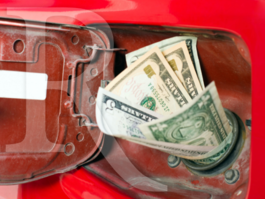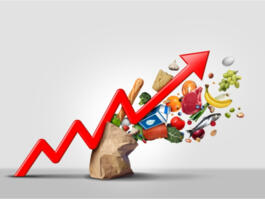Stocks Diss Oil, for Now
A Commentary By Lawrence Kudlow
Big economic-growth stats are trumping oil prices and the Mideast tinderbox. In optimistic trading on Thursday, stocks soared nearly 200 Dow points. Oil barely fell to just under $102 a barrel. Know what? The market may be shouting out that the recent oil spike is not going to derail economic recovery.
Of course, nobody can predict events in wartorn Libya and other hotspots -- or, for that matter, in Saudi Arabia. Sure, if Saudi Arabia erupts into violence on its so-called "day of rage" on March 11, oil prices will spike like we've never seen before, causing incalculable damage to the U.S. and world economies.
But for now, U.S. stock markets have pushed that scenario aside. They're much more interested in ISM reports showing a mini economic boom.
On the manufacturing side of the ISMs, 61 percent of survey participants reported better business. For non-manufacturing services, 60 percent of companies on the composite index and almost 67 percent on the overall business-activity index improved. Together, these supply-manager reports suggest as much as 4 percent to 5 percent economic growth.
Stocks surged on Thursday when the services report was first put out. But additional good news helped stoke the market enthusiasm.
On the employment front, there was a big decline in initial jobless claims, which fell to 368,000. The four-week average of jobless claims now stands at 388,500, the lowest reading since July 2008. And the so-called "whisper number" for Friday's nonfarm payrolls report is approaching 300,000 new jobs.
In addition, car sales have surged to 13.4 million at an annual rate, consumer confidence has unexpectedly improved, and same-store retail sales are well above consensus, coming in over 4 percent in the latest report.
So while stocks have been highly volatile over the past few weeks -- since Libyan oil fields were shut down -- bullish trading suggests that in its wisdom Mr. Market not only believes economic recovery will survive the $10 or $15 jump in oil prices, but that the stock rally is far from over if the economy produces unexpectedly strong growth.
That said, it's also possible that we experience unexpectedly strong inflation.
While Fed head Ben Bernanke remains in full denial, those ISM reports show mounting inflationary pressures. Business prices paid are rising at least 20 percent above year-ago. Commodity indexes are running 30 percent to 40 percent ahead of year-ago. Even the consumer price index has registered back-to-back increases of 0.4 percent for December and January, coming to 5.1 percent at an annual rate.
Bernanke believes that oil, gold, commodities and other upward price pressures will be transitory, so he is determined to keep printing new money through his much-criticized QE2 program. The dollar is suffering. He might be better advised to look across the ocean to European central banker Jean-Claude Trichet.
This week, Trichet signaled that he may raise the ECB target rate in April in order to stop the oil shock and prevent other price increases from spreading. Trichet has become the Paul Volcker of Europe. He will not monetize the oil increase. He is exactly right.
Bernanke on the other hand looks more like Arthur Burns in the 1970s, back when the Fed increased the money supply in an attempt to fight negative oil-shock effects, but instead monetized oil into a raging stagflation.
In any event, I side with clear-eyed Wall Street forecaster John Ryding, who believes the $10 or so oil-price hike will reduce real growth by only 0.25 percent, while adding a like amount to inflation. Ryding expects 3.5 percent growth this year.
Historically, a combination of spiking oil prices and an inverted Treasury yield curve signaling ultra-tight Fed money are precursors to inflationary recession. This has pretty much held true for the last six economic downturns. But right now, the oil spike is modest and Fed money printing is ultra-easy. The yield curve is steep and upward sloping, with long-term rates 350 basis points above short-term rates. This argues against recession right now.
And let's not forget: Corporate profits remain very strong, an extension of the Bush tax cuts is helping the economy grow, and the onetime payroll tax cut may help cushion the oil shock.
So at the moment, barring a blowup in Saudi Arabia, the economy will survive.
In the end, however, a surge in gasoline prices at the pump may be the deciding economic and stock market factor. Pump prices jumped another 4 cents Thursday to a national average of $3.43 per gallon, according to AAA. Gas prices are about 25 percent higher than they were a year ago. Some forecasters are projecting $4 a gallon or more.
If income-producing jobs fall short of Wall Street hopes, the gasoline-tax increase on consumers and small businesses could melt stock market optimism. Besides the Saudi threat, gasoline prices are the biggest "if" in the economic outlook.
COPYRIGHT 2011 CREATORS.COM
See More Commentary by Lawrence Kudlow.
See Other Political Commentary.
Views expressed in this column are those of the author, not those of Rasmussen Reports. Comments about this content should be directed to the author or syndicate.
Rasmussen Reports is a media company specializing in the collection, publication and distribution of public opinion information.
We conduct public opinion polls on a variety of topics to inform our audience on events in the news and other topics of interest. To ensure editorial control and independence, we pay for the polls ourselves and generate revenue through the sale of subscriptions, sponsorships, and advertising. Nightly polling on politics, business and lifestyle topics provides the content to update the Rasmussen Reports web site many times each day. If it's in the news, it's in our polls. Additionally, the data drives a daily update newsletter and various media outlets across the country.
Some information, including the Rasmussen Reports daily Presidential Tracking Poll and commentaries are available for free to the general public. Subscriptions are available for $4.95 a month or 34.95 a year that provide subscribers with exclusive access to more than 20 stories per week on upcoming elections, consumer confidence, and issues that affect us all. For those who are really into the numbers, Platinum Members can review demographic crosstabs and a full history of our data.
To learn more about our methodology, click here.



